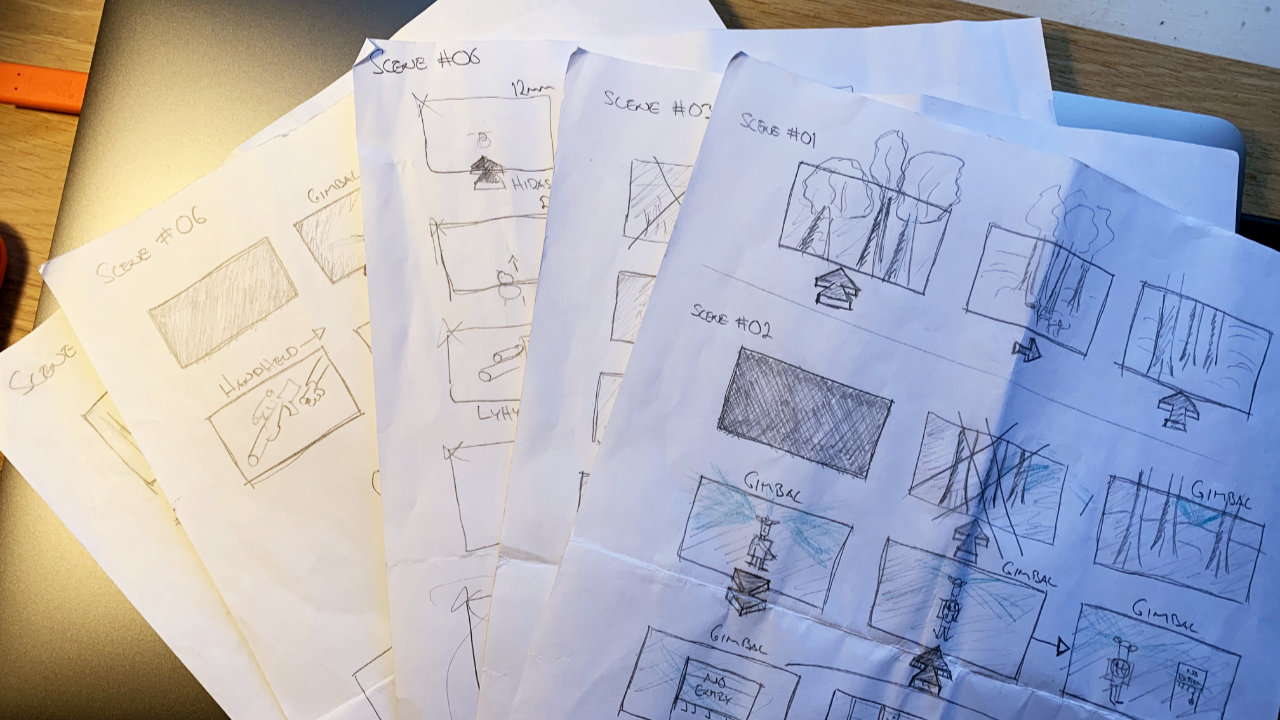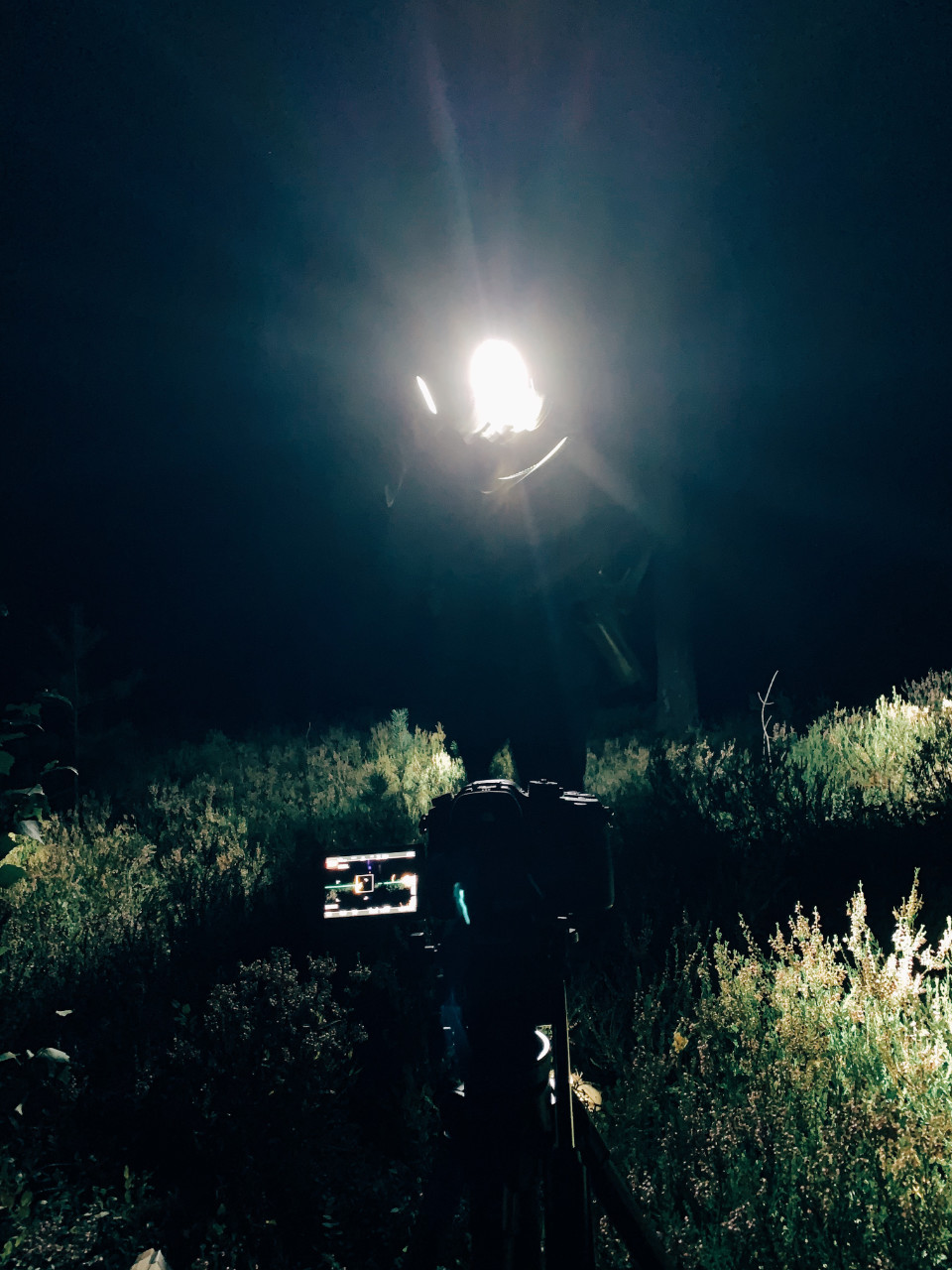
In the previous post I talked about acid testing certain concepts of my story, my current camera setup and the state of my filmmaking skills by creating a shorter version of the story and shooting it quickly. Since then things progressed pretty fast and I did not have much time to even update the Instagram page much less write anything into the blog. We shot for two nights straight for about 3 hours on each night so that we would have enough energy to continue the next day. So as far as night shoots go, this must have been from the light end of the spectrum.
But anyways, I am happy to report that a first assembly cut of the proof of concept film exists! 💪 There is still plenty to do and I am going to head back to the forest during the autumn at least a couple of times.
Below you will find some of the learning from the two shooting nights.
What is still missing
We managed to shoot about 98% of the storyboarded shots but there are couple of missing bits that require a practical effect to be developed, tested and then shot.
In addition to that, there were serious issues with focus on many shots and I need to redo those but this time it should be much more straightforward as I know exactly what I am looking for and how the shots should play out.
After I have the missing parts shot and added to the edit I will jump into the next items on the todo-list:
- tweak the edit into a nicely flowing story
- start recording sound effects and crafting the sound of the film
- I already have a small library of various sounds recorded back in last year
- start the soundtrack writing sessions
- mixing the sound and music
- color correction and grading
What went well
Pre-planning
 Complete storyboards for the short
Complete storyboards for the short
This is the thing that was first of painful learning experience and then turned into an invaluable tool. It took initially quite a long time to plan and draw every shot that should go into the film and I was quite nervous about the process in the beginning and spent probably too much time on it until I found a bit faster process.
First I would quickly block out a plan on paper on how the scene would play out. Then I would dry run it with my brother (who volunteered to act in this production) and work out if the plan makes sense and add the changes into the storyboard / blocking diagram. Then we would shoot a quick prototype with the iPhone and I would quickly edit it together and see how it actually plays out, what shots do I need still and if the rhythm works or not. Based on that quick edit I would revise the storyboard and shotlist. The process might sound like much more work than just drawing the storyboards but for a first timer like me this was valuable hands on experience and I managed to work out lots of problems before we headed out to shoot at night. Once we were at the set, we could just focus on getting the performance and the camera work right now that we had the plan worked out and we didn’t need to stop much to reconsider if the shots work or not.
Keeping things organised
 The trunk of my car worked as the mobile homebase and storage through both nights.
The trunk of my car worked as the mobile homebase and storage through both nights.
Early on in the process, starting from last year I started to pack all the finished props into cardboard boxes and labelling them clearly. This paid off big time now it came time to shoot as I was able to just pick the boxes needed for each night’s shoot and did not need to spend time looking for stuff.
What needs to be improved
Focus
 Shooting one of the scenes at night. GH4 working at the limits of it’s low light capabilities.
Shooting one of the scenes at night. GH4 working at the limits of it’s low light capabilities.
As mentioned above, many of the failed shots that are in need of a reshoot were seriously out of focus. This is one big pain point in the current concept as my current camera is pretty much maxed out in terms of how far we can push it’s ISO setting without creating too much noise. As such, I’ve had to shoot with the lens wide open (Rokinon/Samyang 12mm T2.0) and that makes it hard for a novice like me to hit the focus all the time. With some more practise and better tools I’m hoping to remedy this problem but if I want to go and shoot the longer version of the story I have planned I need to work on this more.
Night shoots are inherently hard!
Here are some challenges that you might experience if you decide to shoot at night in a dark forest.
- Not finding the set
- solution: buy some reflective tape please and mark your set or leave a light burning on the spot
- Not finding your way out of the set after you wrap up
- same as above but in reverse
- Giving direction to actors when everything looks exactly the same
- Hard for the actors to find a way in the dark forest
- solution: use the reflective tape to mark the path but make sure it is not visible in the shots
- Cinematographer almost tripping on his feet as he cannot use any lights because they would break the shot
- Hard to do tracking shots from the front as need to walk backwards in the dark with all the obstacles that a regular forest has
- solution: I don’t know for sure, a cable rig might work or have someone to support you as you walk backwards or build a stable track for walking
More prep, more testing
There can probably never be enough so get as much as you can.
Also if you have some practical effects, take your time to test how they look in actual use. I have couple of props with a glowing effect but once I saw it in the edit, the effect felt too mechanical and thus I will have to reprogram it and also go back and reshoot the scenes containing the prop. “Thankfully” these scenes also had the focus issues so replacing them is not so painful.
Gear updates
Couple of additions to the rig that would make the process of shooting faster and more comfortable
- follow focus
- should help getting the focus right easier
- already ordered and looking forward to using it on the pick up shoot!
- extra lights, LED panels, etc.
- using available light that is motivated by the story has been the concept of the look of this film but there were some instances when the option to use some soft fill light to better illuminate the face of the actor would have been appreciated
- audio recorder that does not run out of juice after 30min
- or consider getting microphones that run the phantom power from a separate battery
Filed under nice to have:
- bigger gimbal for rigging and better ergonomics
- Zhiyun Crane Plus is a good and economical gimbal but for shooting longer periods of time it is just not very comfortable
- better screen
- I have a cheap 5” Andycine 4K monitor that often falls short but some improvements could be achieved by calibrating it better
- 2 cameras (optimally)
- one rigged to gimbal
- one rigged for tripod, shoulder and handheld shots
- should speed up changing the mode of shooting but can live without it
Additional crew
Because shooting almost alone is not the most optimal thing, who would have thought :D Lots of my energy and focus was spent on technicalities instead of working out the story and performance. In the future I am hoping to find collaborators to bring these stories to life.
- prop handler
- sound recordist
- camera assistant and/or cinematographer
- I would be more than happy to step down from handling the camera but as of now will keep myself as the backup cinematographer in case other options are not available